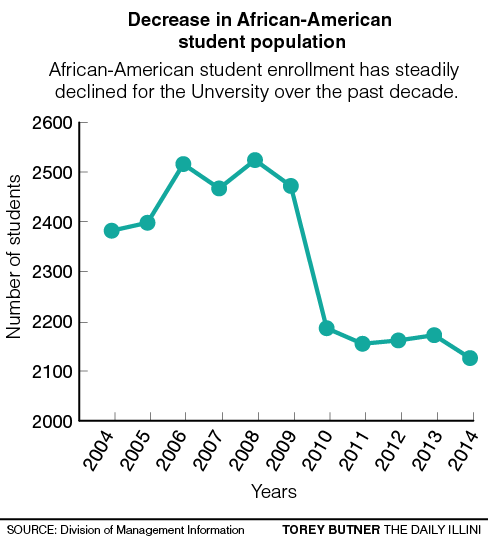University’s African-American population declines

December 16, 2014
Over the last decade, the African-American population on campus has faced a heavy decrease.
Only 356 African-American freshmen enrolled in the fall semester, of the 945 that were accepted into the University, according to the Division of Management Information.
The yield — the number of students that enrolled in relation to those accepted — has fallen below that of the incoming class of African-American freshmen in fall 1968, the year “Project 500” took place. The project was an initiative to boost African-American enrollment following the assassination of Martin Luther King Jr.
Corey Evans, Men of Impact president and senior in AHS, agreed the increase in tuition plays a potential role in turning African-American students away.
“I would say that the tuition increase is probably one of the biggest factors because, statistically speaking, it’s harder for African-Americans coming from lower-income families than other students,” Evans said in October.
Get The Daily Illini in your inbox!
Keith Marshall, associate provost, said in an email in October that administration monitors admissions data and enrollments carefully, and the Office of Undergraduate Admissions has been aware of the decline in African-American enrollments “for some time.”
With respect to the cause for the decrease, Marshall said surveys conducted suggest that students who applied to the University but chose not to attend did so primarily due to the high cost of tuition and the lack of sufficient financial aid.
“The University of Illinois is committed to enrolling a diverse freshman class, and the decreasing enrollments of African-American students is unacceptable to anyone committed to that goal,” Marshall said.
Rory James, director of the Bruce D. Nesbitt African American Cultural Center, said in October he considers the tuition a major factor in the decline.
“I just find it personally, and professionally, problematic when black students from Illinois who really want to come here can’t come to a land-grant institution,” James said.
James said he has faith in the University to increase the numbers, if the center continues to engage in conversation with University administration to come up with solutions to encourage more African-Americans to attend the University.
“We have to make (African-Americans) feel like they’re welcome and we have to make them feel like they’re wanted here; I think when we start doing those things, we’ll see the numbers increase.” James said.
Renee Romano, vice chancellor for student affairs, said in December that admissions was partnering with the Office of Inclusion and Intercultural relations, as well as the Bruce D. Nesbitt African American Cultural Center, to involve students in the recruitment process.
“They have created a student ambassador and a tele-counseling program that will involve our current students in hosting visiting prospective students and tele-counseling, which will involve our current students calling prospective students throughout the decision-making process,” Romano said.
Romano said University administration continues to consider solving the decline a priority and have always been focused on supporting the University’s African-American population, but have significantly been more engaged in the issue since last spring, participating discussions with student leaders on how the campus climate could be improved.
Faraz can be reached at [email protected].






